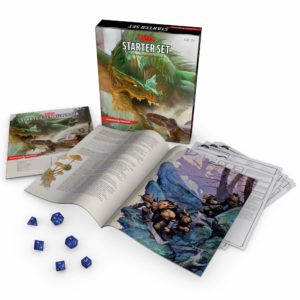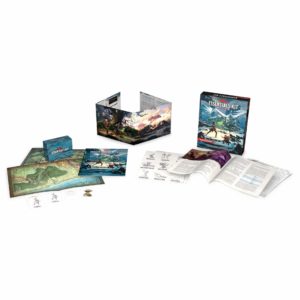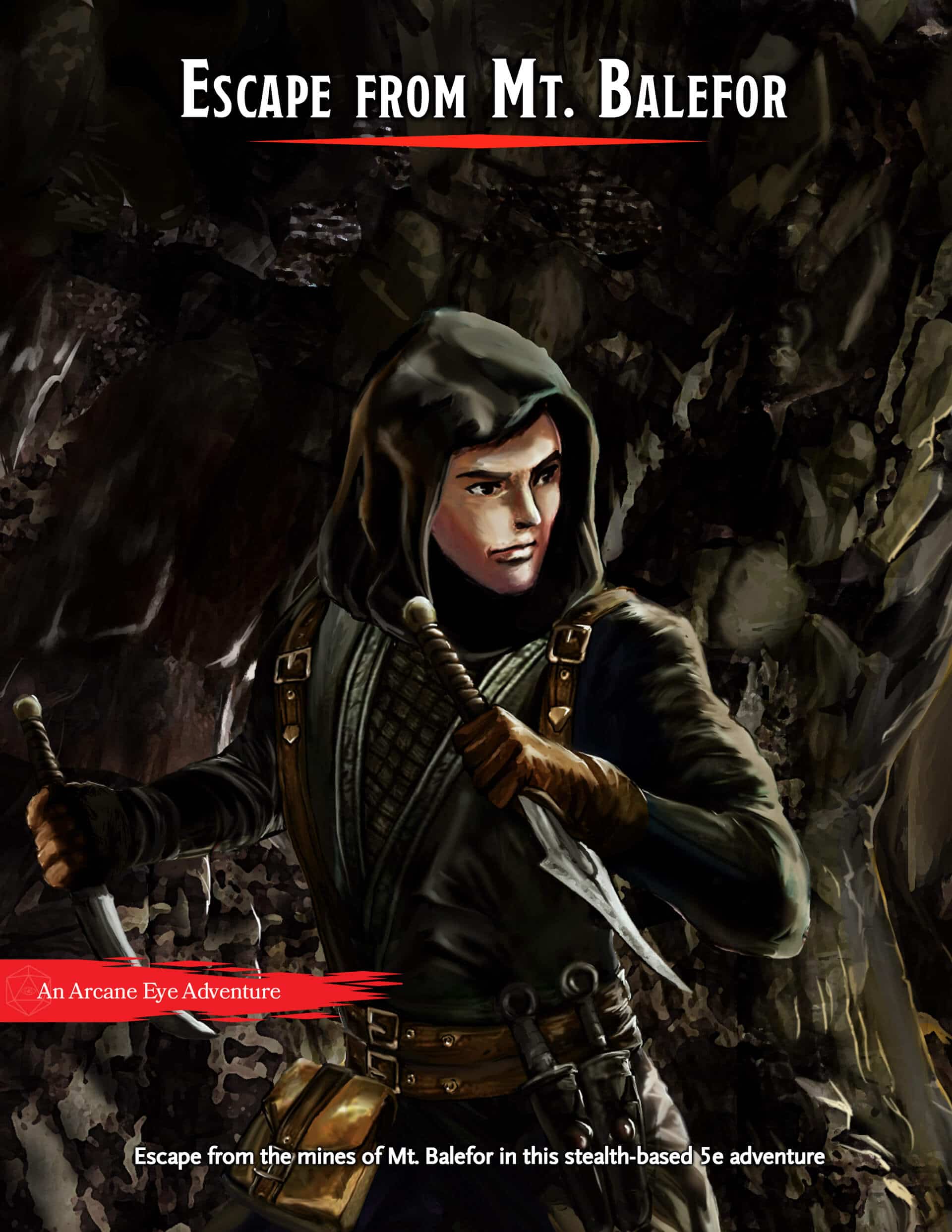What’s Included:

Starter Set
$19.99 at Amazon

Essentials Kit
$19.99 at Amazon
The Starter Set is intended as an introduction to the world of Dungeons & Dragons. It is aimed at complete beginners to the TTRPG genre. Contents: 32-page D&D rulebook, 64-page adventure book: The Lost Mine of Phandelver, 5 ready-to-play characters, 6 game dice. The Essentials Kit is intended to give new D&D players everything they need to run a long-term campaign. Contents: 64-page D&D rulebook, 64-page adventure book: Dragons of Icespire Peak (plus code for digital edition), double-sided poster map, Dungeon Master screen, 6 blank character sheets, 11 game dice, 81 reference cards for combat, status, magic items, and non-player characters, 50% off the digital edition of the Player’s Handbook on D&D Beyond. Pros: The streamlined rulebook and pre-generated character sheets are perfect for beginners. A very good introductory adventure, featuring well-crafted combat scenarios, a dungeon crawl or two, and easy-to-follow towns The more detailed rulebook and blank character sheets allow for more unique character creation The 50% off code for the DM screen, combat cards, and Player’s Handbook provides long-term value not found in the Starter Set The double-sided poster map is a great prop to help players and DMs visualize the key regions of this adventure Cons: Character options are very limited unless you create your own While you can roll the dice provided in the set, the game flows much better if each player (and DM) has their own set. Character creation can be complicated for TTRPG newbies Dragons of Icespire Peak has a weaker overall story than Lost Mine of Phandelver Although you can roll the dice provided in the set, the game flows much better if each player (and DM) has their own set.
The perfect adventure for D&D beginners
Starter Set – Winner
The Starter Set includes Lost Mine of Phandelver (LMoP), one of the most well-received 5e adventures to date, and extremely well-constructed for beginning DMs and players. While the module is intended as a basic introduction to tabletop D&D, it excels in many ways in the pacing and structure of the adventure.
The adventure takes place in a fairly small, unspecified geographical area of the Forgotten Realms, but could easily fit into any high fantasy setting.
Strong Points:
Lost Mine of Phandelver is a great start to any D&D campaign, intended as a springboard for DMs to begin their own adventures upon completion, or to jump into another module such as Storm King’s Thunder that starts at level 5. The module contains some well-crafted combat scenarios, a dungeon crawl or two, and a not-too-large town, all of which act as great tools to familiarize your party with the world of D&D.
Cons:
The first chapter of the adventure is very unsettling for a level 1 player. The player either survives the goblin encounter in one fell swoop or is easily killed due to their scarce hit points. The villain is not particularly compelling; however, with enough effort, you can portray him as a minion of a greater evil. Once the player completes the adventure, they can set off on the next quest.
Essentials Kit
Dragons of Icespire Peak (DoIP) is an adventure included in the Essentials Kit. It takes place in roughly the same locations as LMoP, but its story structure and pacing are not as well received as its predecessor.
The adventure revolves around a young white dragon who has made his nest in the area surrounding Phandelver. Players begin the story in the town of Phandelver, where they will have to complete quests located on a job board. Once jobs are completed, several side quests will be launched, giving players the chance to level up even further.
None of these side quests explicitly lead the party to Icespire Hold, the location of the young white dragon, but there is an option to lead the party towards the dragon when the party is ready to fight it.
Strong Points:
While it’s hard to get wrapped up in the story, Jobboard offers short, well-structured, one-session adventures with a lot of player freedom and fun non-linear storytelling.
Cons:
Level 1 characters are very likely to be killed by mistake. In this module, level 1 characters fight some pretty nasty foes, including a CR 3 manticore. There is a weak plot hook at the beginning of the campaign that a novice DM may struggle with. There is no clear, overarching plot that leads the party to the white dragon’s lair.
How are the rulebooks different?
Each kit comes with an abbreviated rulebook that provides a concise set of rules for the DM to run a game. Note that these rulebooks are not the same as the Core Rules or Dungeon Master’s Guide, which provide a more detailed explanation of the rules and tools that can be used to run a game of D&D.
In essence, the rulebooks for each kit are essentially the same, but let’s look at the differences.
Starter Set – Winner
The Starter Set rulebook is 32 pages, half the size of the Essentials Kit’s, but bigger isn’t necessarily better in this case. The Starter Set rulebook is very streamlined when it comes to teaching new DMs how to play the game. After reading the first 16 pages, any DM will be ready to run their first game.
The Starter Set comes with pre-generated character sheets, so the rulebook skips the rules on character creation and gets you straight to the basics of adventuring, exploration, and combat. If you’re just learning the game, there’s no better document than the Starter Set rulebook. However, if you already know the basic rules, this document won’t be of much use to you.
Essentials Kit
The Essentials Kit rulebook has twice the number of pages as the Starter Set, but it’s not twice as valuable: Chapters 2, 3, and 4 of this rulebook (on Game Play, Equipment, and Spells, respectively) are essentially the same as what’s provided in the Starter Set rulebook.
The biggest difference between the two rulebooks is that the Essentials Kit includes 27 pages of character creation rules, allowing players to choose a race (dwarf, elf, half-human, or human), a class (bard, cleric, warrior, thief, or wizard), and a background (acolyte, criminal, entertainer, sage, or soldier).
While this is not all of the options offered in the Player’s Handbook, it does allow players to customize their characters up to 6th level. This is in contrast to the Starter Set, which provides a set track that takes players from 1st to 5th level.
The Essentials Kit also includes several pages of magic items players can find, as well as the mechanics for running Sidekicks in D&D 5e.
Cost performance
Starter Set
The Starter Set serves as a great introduction to the world of D&D, but it doesn’t offer much value beyond your first adventure. As soon as you reach level 5, you’ll want to turn to either the Core Rules, the Player’s Handbook, or D&D Beyond to find more content for your party’s characters. You’ll also want to find out where to head next to continue your adventure. See the “What’s next” section of this article for more information.
Essentials Kit – Winner
This is where the Essentials Kit trumps the Starter Set. For roughly the same cost, the Essentials Kit offers slightly more value for your money. Here’s why:
The rulebook contains rules for creating player characters, so you can start another 1st level adventure after finishing Dragon of Icespire Peak and create a brand new character. The rulebook is of higher quality than the one in the starter set, as it has a bound spine instead of stapled. The accessories can be used in later sessions. These accessories, in order of value, are a DM’s screen, magic item cards, and a poster map. The one-page adventures provided in this book serve as great templates for creating your own adventures. They can also be used in other campaigns that you did not complete while playing this module. The kit includes the Player’s Handbook from D&D Beyond at 50% off, saving you $15 on a very important $30 book. It provides more dice than the starter set, but you will likely need to purchase more if you are going to play directly.
Which wins out: the Starter Set or the Essentials Kit?
As you will see from reading this article, there is no clear “best” starter kit. Based on what you are looking for in a starter kit, you can make an informed decision between the two below.
If you’re buying a starter set…
You and your table are complete beginners to D&D, and you want to dip your toes into the world of TTRPGs before investing too much time, money, and brainpower. You’d like a little more guidance in reading the D&D rules and planning adventures.
Buy the Essentials Kit if…
You and your table are intermediate board game or RPG players. You want the ability to customize the story to your liking, and your players would like more character customization options. You plan to play D&D beyond the introductory adventure. You wouldn’t be afraid to tweak the story to make it more appealing to your players.
What comes next after the starter kit?
These kits are perfect for beginning your journey into the world of D&D and TTRPGs. After you’ve completed the introductory adventure, or if you want to move on, where should you adventure next?
homemade
Homebrew is when a DM creates their own adventure. They can take inspiration from other sources, but the story their characters act out is their own. Many DMs find this to be the most time-consuming, yet also the most creatively satisfying way to run an adventure.
First-party sources
Wizards of the Coast has a ton of high-quality pre-made adventures starting at 5th level, and you can read all about their official 5e adventures here.
Third Party Sources
There are many creators who make their own adventures for others to play. The official source for finding these adventures and other homebrew content is the DMs Guild. Arcane Eye has also published one or two adventures. If you enjoy our content, please check it out in the Arcane Eye Shop.
Other Games
You love D&D and want to see what other games are out there, or you don’t really like it and want to try something different – that’s fine! Our article Tabletop Games to Play If You Love D&D lists some other games to check out to continue your foray into the world of tabletop gaming. If you prefer video games, check out some of our recommended video games for D&D fans.
Conclusion
I hope you enjoyed this comparison review of the D&D Starter Set vs Essentials Kit, if you would like me to review other products in detail please feel free to leave a comment below.
Fill out the form below to receive your free copy of “Escape From Mt. Balefor”!

Or follow us on Instagram, Twitter and YouTube.

